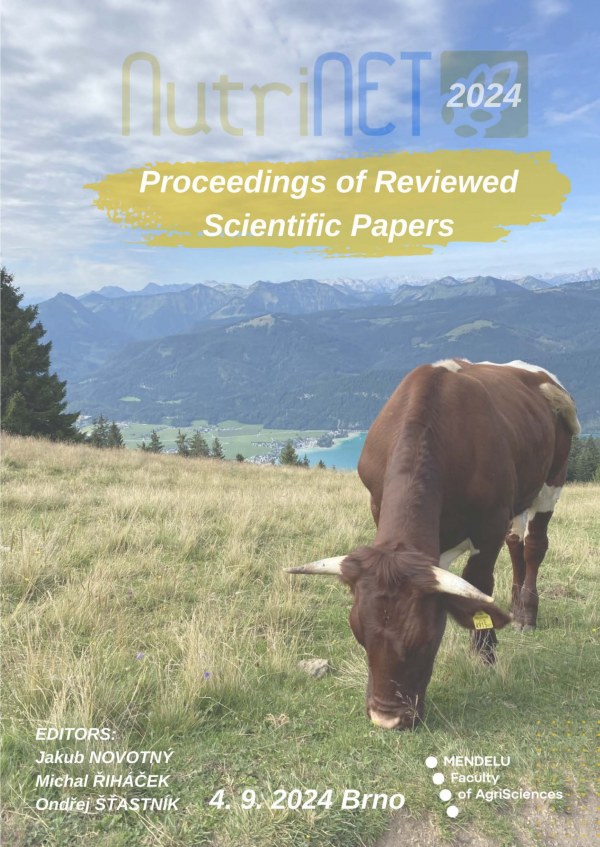
DOI: 10.11118/978-80-7509-994-5-0318
FEED UTILIZATION OF FOXTAIL MILLET (SETARIA ITALICA) GRAIN IN BROILER DIETS
- JAKUB NOVOTNÝ1, MICHAL ŘIHÁČEK1, ONDŘEJ ©«ASTNÍK1, EVA MRKVICOVÁ1, MILENA BIELANOVÁ1
The aim of the study is the determination of the retention of crude protein (CP) and crude fat in the organism of broiler chickens after the addition of Foxtail millet (Setaria italica (L.) Beauv.) to the diet. At the same time, the performance parameters (live weight, carcass weight, feed conversion ratio (FCR)) were evaluated. Ross 308 male broiler chickens were included in the 36-day experiment, which were fed ad libitum diet of control (C), 5% of Foxtail millet (FM5) and 40% of Foxtail millet (FM40). In addition, their composition included the chromium oxide indicator (0.3%), which was used to determine the coefficients of apparent digestibility and retention of the already mentioned nutrients. The retention of CP was 67.78 % in the control mixture, 66.19% in the mixture FM5 and 68.62% in the mixture FM40. For crude fat, it was on average 84.95% (control mixture), 86.57% (FM5) and 90.21% (FM40). The CP retention of Foxtail millet was set at an average 73.15% over the observed period. There were no significant differences in the biochemical analysis of the blood (p > 0.05) as well as in the production qualities of broiler chickens (assessed by the Scheffe test). The average carcass content was 69.07% for the control group, 69.05% for the FM5 group and 68.93% for the FM40 group. Feed conversion ratio was average 1.28 for control group, 1.32 for FM5 and 1.34 for FM40. Foxtail millet can therefore be included to the diet without negative impact on the health of the chickens or the nutrient retention, which increased compared to the control diet when 40% of the foxtail millet was added to the diet.
Klíčová slova: nutrient retention; poultry nutrition; alternative crop; performance parameters
stránky: 318-328, online: 2024
Reference
- Aviagen. 2018. Technologický postup pro výkrm brojlerů Ross. In: Aviagen®. Huntsville (Alabama): Aviagen.
- Aviagen. 2019. Ross 308 and Ross 308 FF Broiler Performance Objectives. In: Aviagen®. Huntsville (Alabama): Aviagen.
- Batonon-Alavo, D. I.; Umar Faruk, M.; Lescoat, P.; Weber, G. M., BastianellI, D. 2015. Inclusion of sorghum, millet and cottonseed meal in broiler diets: a meta-analysis of effects on performance. Animal. 9(7): 1120-1130.
 Přejít k původnímu zdroji...
Přejít k původnímu zdroji... - Boroojeni, G. F.; Samie, A. H.; Edriss, M. A.; Khorvash, M.; Sadeghi, G.; Van Kessel, A., Zentek, J. 2011. Replacement of corn in the diet of broiler chickens using foxtail millet produced by 2 different cultivation strategies. Poultry Science. 90(12), p. 2817-2827.
 Přejít k původnímu zdroji...
Přejít k původnímu zdroji... - Bugalia, H. L.; Mathur, M. C.; Yadav, C. M., Upendra, K. 2009. Influence of Different Levels of Foxtail Millet (Setaria italica) on the Performance of Broiler Chicks. Indian Journal of Animal Nutrition. 26(3): 280-282.
- Hermuth J.; Janovská, D., Prohasková, A. 2015. Bér vlaąský Setaria Italica (L.) Beauv.: vhodná plodina do měnícího se klimatu České republiky, Praha: Výzkumný ústav rostlinné výroby. Metodika pro praxi.
- Pack M.; Hoehler, D., LemmE, A. 2003. Economic assessment of amino acid responses in growing poultry. In: D'Mello, J. P. F. (ed.). Amino acids in animal nutrition. 2nd ed. Willingford, Oxon, UK; Cambridge, MA, USA: CABI Pub. 459-484.
 Přejít k původnímu zdroji...
Přejít k původnímu zdroji... - Rao, S.V.R.; Reddy, M. R.; Prarharaj, N. K., Sunder, G. S. 2000. Laying Performance of Broiler Breeder Chickens Fed Various Millets or Broken Rice as a Source of Energy at a Constant Nutrient Intake. Tropical Animal Health and Production. 32(5): 329-338.
 Přejít k původnímu zdroji...
Přejít k původnímu zdroji... - Reddy, P. S., Narahari, D. 1997. Utilization of foxtail millet (Setaria italica) and its processed forms on performance of broilers. Indian Journal of Animal Sciences. 67(3): 237-240.
- Shekhawat, R. S. a Kumar, U. 2016. Effect of replacing maize by Kangni (Setaria italica) on body measurement and carcass traits of broilers. Annals of Agricultural Sciences. 38(3): 342-346.
- Shekhawat, R. S.; Mathur, M. C., Kumar, U. 2013. Effect of replacing maize by Kangni (Setaria italica) on performance of broilers. Veterinary Practitioner, c/o Dr. A. K. Gahlot. 14(1): 20-22.
- Tirajoh, S.; Achmanu, Sjofjan, O., Widodo, E. 2014a. Effect of gradual inclusion of papua foxtail millet (Setaria italica sp) to substitute yellow corn on breast meat quality and blood profiles in broilers. International Journal of Agronomy and Agricultural Research (IJAAR). 4(6): 104-109.
- Tirajoh, S.; Achmanu, Sjofjan, O. a Widodo, E. 2014b. Evaluation of nutritive values of Papua foxtail millet (Setaria italica sp) and its substitutive effect for yellow corn on broiler performances. International Journal of Agronomy and Agricultural Research (IJAAR). 4(5): 195-201.
- University of Kentucky. ©2017. Millets. University of Kentucky College of Agriculture, Food and Environment. Lexington (Kentucky).
- Verma, S.; Srivastava, S. a Tiwari, N. 2015. Comparative study on nutritional and sensory quality of barnyard and foxtail millet food products with traditional rice products. Journal of Food Science and Technology. 52(8):5147-5155
 Přejít k původnímu zdroji...
Přejít k původnímu zdroji... - Zeman, L. a kolektiv. 2006. Výľiva a krmení hospodářských zvířat. Praha: Profi Press. ISBN 978-80-86726-17-5.


